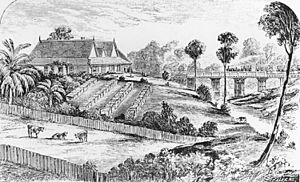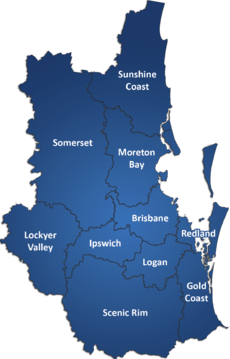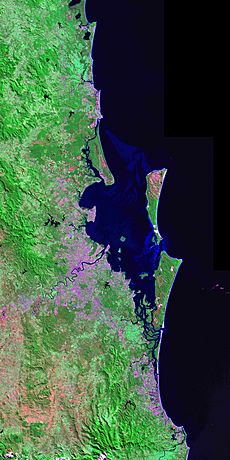South East Queensland facts for kids
Quick facts for kids South East QueenslandQueensland |
|||||||||||||||
|---|---|---|---|---|---|---|---|---|---|---|---|---|---|---|---|
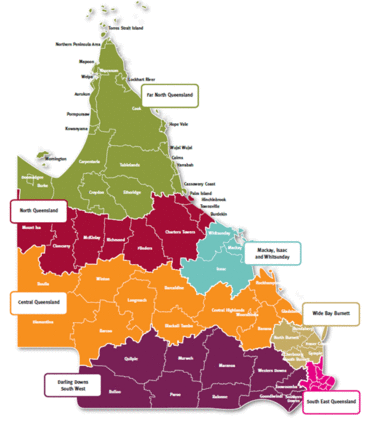
Regions of Queensland with South East Queensland in the bottom right hand corner of the state
|
|||||||||||||||
| Population | 3,800,000 (2020) | ||||||||||||||
| • Density | 107.8/km2 (279/sq mi) | ||||||||||||||
| Established | 1824 | ||||||||||||||
| Area | 35,248 km2 (13,609.3 sq mi) | ||||||||||||||
| LGA(s) | City of Brisbane, City of Gold Coast, Somerset Region, Sunshine Coast Region, Moreton Bay Region, Redland City, Logan City, Shire of Noosa, Scenic Rim Region, City of Ipswich, Lockyer Valley Region, Toowoomba Region | ||||||||||||||
|
|||||||||||||||
South East Queensland (SEQ) is a bio-geographical, metropolitan, political, and administrative region of the state of Queensland in Australia, with a population of approximately 3.8 million people out of the state's population of 5.1 million.The area covered by South East Queensland varies, depending on the definition of the region, though it tends to include Queensland's three largest cities: the capital city Brisbane; the Gold Coast; and the Sunshine Coast. Its most common use is for political purposes, and covers 35,248 square kilometres (13,609 sq mi) and incorporates 11 local government areas, extending 240 kilometres (150 mi) from Noosa in the north to the Gold Coast and New South Wales border in the south (some sources include Tweed Heads (NSW) which is contiguous as an urban area with Brisbane/Gold Coast), and 140 kilometres (87 mi) west to Toowoomba (which is simultaneously considered part of the Darling Downs region).
South East Queensland was the first part of Queensland to be settled and explored by Europeans. Settlements initially arose in the Brisbane and Ipswich areas with activity by European immigrants spreading in all directions from there. Various industries such as timber cutting and agriculture quickly developed at locations around the region from the 1840s onwards. Transport links have been shaped by the range of terrains found in South East Queensland.
The economy of South East Queensland supports and relies on a wide diversity of agricultural manufacturing industries, commerce and tourism. The region has an integrated public transport system, TransLink. The gross domestic product is $ 170 billion
Contents
Definitions
South East Queensland, classified as an interim Australian bioregion, comprises 7,804,921 hectares (19,286,380 acres) and includes the Moreton Basin, South Burnett, and the Scenic Rim along with ten other biogeographic subregions. The term South East Queensland has no equivalent political representation. The area covers many lower house seats at the federal and state levels. As Queensland has no upper house, there are no Legislative Council provinces or regions to bear the name either.
History
South East Queensland was home to around 20,000 Aboriginals prior to British occupation. The local tribes of the area were the Yuggurapul of the Central Brisbane area; the Yugumbeh people whose traditional lands ranged from South of the Logan River, down to the Tweed River and west to the McPherson Ranges; the Quandamooka people whose traditional lands encompassed the Moreton Bay Islands to the mouth of the Brisbane River to Tingalpa and south to the Logan River; and the Gubbi Gubbi people whose traditional lands were known to exist north of the Pine River, to Burrum River in the north, and west to the Conondale ranges. According to history researchers the Aboriginal population declined to around 10,000 over the next 60 years.
Early explorers in the area including Matthew Flinders, Allan Cunningham, John Oxley and Patrick Logan. Around 1839, European settlers were able to move into the region. Logging was the first industry to develop. The first railway built in Queensland linked Grandchester to Ipswich in 1865 along a narrow 1067 mm gauge.
Major floods were experienced in 1893, 1974 and 2011. In 2005, the region suffered its worst drought in recorded history.
Geography
Queensland's third highest peak, Mount Barney, is located in the south of the region. The Cunningham Highway passes southwest to the Darling Downs via Cunninghams Gap. Several highways including the Bruce Highway, Warrego Highway and the Pacific Motorway link to the adjoining regions.
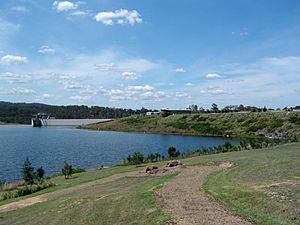
The region is mountainous. McPherson Range, Teviot Range, D'Aguilar Range, Little Liverpool Range, Blackall Range as well as the Springbrook Plateau and Tamborine Mountain Plateau. Isolated volcanic peaks are found at Moogerah Peaks and the Glass House Mountains. Along the coast are several large islands including Bribie Island, Moreton Island and North Stradbroke Island with many smaller islands in Moreton Bay. Several major water supply and flood mitigation dams have been constructed here. The Western Corridor Recycled Water Scheme and Gold Coast Desalination Plant were recently built to counter the effects of drought in South East Queensland.
Regions and local government areas
South East Queensland generally consists of the following regions, each of which is also a local government area (LGA):
- Brisbane - the capital and largest city of Queensland. The Brisbane metropolitan area consists of the City of Brisbane, as well as the following local governments:
- Ipswich City - an outer-suburban city with an industrial and mining heritage west of Brisbane.
- Logan City - a largely residential area between Brisbane and the Gold Coast.
- Moreton Bay Region - a largely residential area between Brisbane and the Sunshine Coast.
- Redland City - a residential and agricultural area on the shores of Moreton Bay to the south-east of Brisbane.
- City of Gold Coast - a major tourist and retirement destination to the south of Brisbane, and the largest non-capital city in Australia.
- Sunshine Coast Region - a coastal tourist and agricultural region to the north of Brisbane. The Glass House Mountains are a symbol of this region.
- West Moreton, a rural area in the Great Dividing Range consisting of:
- Toowoomba City - the Toowoomba city is included in both the South East Queensland region and within Western Downs (although the full Toowoomba region is only in western downs) region due to its importance to both regions as a gateway city providing access to the west of the state.
- Lockyer Valley Region - an agricultural area west of Ipswich, known for its fruit and vegetable production.
- Scenic Rim Region - a pastoral area inland from the Gold Coast known for its scenic mountains and villages.
- Somerset Region - a pastoral area north west of Brisbane and location of two major dams supplying South East Queensland with water. This area is also known as the Brisbane Valley.
The Tweed Shire is actually within NSW but is often included in planning processes for SEQ. While not officially part of the TransLink public transport network, Surfside Buses run a seamless service across the border that appears to passengers as though it is integrated.
A highly effective integrated ticketing system for public transport has averted transport gridlock in the region.
Major cities
The region is a complex, regional hybrid linking Brisbane with several surrounding cities. South East Queensland includes the following regional cities:
- Brisbane, Queensland's capital and largest city
- Gold Coast, Queensland's premier tourist destination and surfing mecca to the south of Brisbane.
- Sunshine Coast, another major tourist area to the north of Brisbane.
- Toowoomba, nicknamed 'The Garden City', the most populous inland city in the country after the national capital, Canberra.
- Ipswich, Queensland's oldest provincial city and industrial centre to Brisbane's south-west.
- Logan, a city between Brisbane and the Gold Coast, mostly residential with some light industry.
- The Redlands, a residential and agricultural bushland/coastal area south-east of Brisbane.
- Redcliffe, a seaside urban area between Brisbane and the Sunshine Coast.
New urban centres are currently being develop at Springfield, Ecco Ripley, Yarrabilba and Flagstone. Some geographers suggest several more master-planned communities will be needed to cater for the expected population growth rates.
Airports
- Brisbane Airport - The major international gateway to the region offering services direct to California, Asia, Oceania and the Middle East.
- Gold Coast Airport - The second major gateway is one of Australia's fastest growing airport offering services to Japan, Malaysia, New Zealand and Singapore.
- Sunshine Coast Airport - A domestic airport offering services to Sydney and Melbourne.
- Brisbane West Wellcamp Airport - The first privately funded major airport in the country. Services the Toowoomba and surrounding Darling Downs region, with a view to becoming a major international freight hub.
- Archerfield Airport - a general aviation airport located approximately 11 km south of the Brisbane CBD.
- Redcliffe Airport - a general aviation airport located on the Redcliffe Peninsula approximately 28 km from the Brisbane CBD.
- RAAF Base Amberley - the largest operational base of the air force in Australia located in south-western Ipswich approximately 50 km from the Brisbane CBD.
Demographics
As of 2014, the population of South East Queensland is estimated to be approximately 3.4 million, meaning that between one in six and one in seven Australians call the region home. The regional population is heavily urbanised and concentrated along the coast. The three largest population centres of Brisbane, Gold Coast and the Sunshine Coast account for 90 per cent of the region's population. In the year to June 2020, the City of Ipswich was the fastest growing local government area in Queensland.
Immigration and population growth
South East Queensland is one of the fastest-growing regions in Australia. Growth in the state is fueled principally by migration from the southern states and overseas. In 2010, South East Queensland's population grew by an average of about 1,200 new residents each week.
Between 1991 and 2016 the population rose from 1.9 million residents to 3.3 million. South East Queensland is expected to be home to 4.4 million by 2031. A 2010 report concluded that the region will reach 5.5 million people by 2051.
Population growth was putting pressure on schools and hospitals in the region in 2021.
Regional planning
South East Queensland's future development will be heavily based on the South East Queensland Regional Plan, released by the Queensland state government in 2005. The regional plan covers the period from 2009–2031 and focuses on slowing development along the coast, in order to prevent creating a 200 km city, and instead aim for growth in the west, in particular around Springfield and Beaudesert. Infrastructure planning in South East Queensland is almost exclusively designed to facilitate trans-metropolitan travel and reduce traffic congestion.
Images for kids


